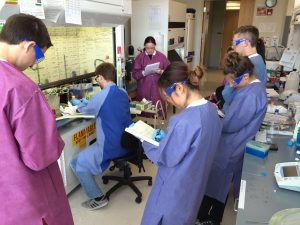Bioseparations and bioprocessing
Affinity purification with stimuli-responsive peptide ligands
 The purification of labile therapeutics, including stem cells, therapeutic enzymes, and blood coagulation factors, is a challenging area in bioseparations. The low biochemical stability of these targets makes it very hard to achieve high product recovery and purity together with high bioactivity. To address these issues, we are working on developing ligands that can selectively capture and release labile therapeutics upon exposure to visible/IR light or under narrow temperature variations. Current targets include stem cells, mitochondria, and therapeutic enzymes.
The purification of labile therapeutics, including stem cells, therapeutic enzymes, and blood coagulation factors, is a challenging area in bioseparations. The low biochemical stability of these targets makes it very hard to achieve high product recovery and purity together with high bioactivity. To address these issues, we are working on developing ligands that can selectively capture and release labile therapeutics upon exposure to visible/IR light or under narrow temperature variations. Current targets include stem cells, mitochondria, and therapeutic enzymes.
Truly continuous downstream bioprocessing
Industrial protein purification using “bind-and-elute” techniques is burdened by large footprint, high consumption of buffer, costly chromatographic media, and long process times. To overcome these issues, we propose a new paradigm for “truly continuous” protein purification, hinged on the retention of contaminants rather than product. In particular, we plan to develop polyclonal mixtures of synthetic ligands immobilized on disposable media for capturing the impurities, while letting the product flow through unbound. Current studies are directed towards IgG and Influenza A vaccines.
Multiple gradient chromatography
Coupling gradients of ionic strength, pH, and polarity is a powerful analytical strategy that enables to efficiently fractionate highly complex protein mixtures. Controlling coupled gradients in a finely tuned manner, however, is very difficult. In collaboration with an industrial partner (http://cryobiophysica.com), we are exploring the potential of combined gradients for high resolution protein separation from extremely complex protein sources (blood, plant extracts) and identification of glycosylated forms. Studies are ongoing on identification of glycoforms of human transferrin (~ 1000) by mass spectrometry.
Non-woven affinity membranes
Novel, robust, and inexpensive affinity media are crucial to improve the performance and decrease the cost of manufacturing biologicals for human therapy. To this end, we develop novel chromatographic membranes based on non-woven fabrics, modified with an hydrophilic layer and functionalized with ligands for protein capture. The high number of binding sites combined with high membrane porosity and mechanical resistance result in media characterized by high binding capacity and low pressure drops. Owing to the low cost of base materials and functionalization methods, the resulting membranes are inexpensive and can be utilized as disposable adsorbents.
Drug Delivery
Scheduling and Synergism in drug delivery
Controlling the ratio and release kinetics of combinations of drugs is crucial to maximize the therapeutic efficacy and minimize undesired off-target effects. To this end, we are developing stimuli-responsive hydrogels that are capable to release synergistic combinations of drugs according to a predetermined schedule, simply by applying external stimuli, such as magnetic field and light. Hydrogels with different chemical composition, structure, loading, and triggers are under development for the treatment of breast cancer and osteoarthritis. Rheological tests, combined with in vitro and in vivo characterization are performed to optimize drug release in response to stimuli.
Transdermal vaccination
Skin hosts a remarkably immunocompetent system, which makes transdermal (“through skin”) delivery ideal for vaccination. Skin, however, is a robust multi-layer barrier that opposes a strong resistance to the transport of foreign species. In particular, crossing the outmost skin layer, the stratum corneum, in a non-disruptive manner and reaching the dendritic cells to trigger an immune response is very challenging. To develop a practicable technology for transdermal vaccination, we are working on the identification of skin-permeating peptides (SPPs). To this end, we utilize libraries of SPP-antigen conjugates and microfluidic devices that mimic human skin. The selected conjugates will enable to replace needles with sprayable patches for vaccination and treatment of skin disorders.
Other topics
Stem cell manipulation
…
Peptoid models for polymer science
…